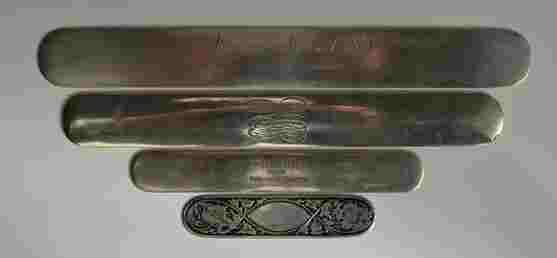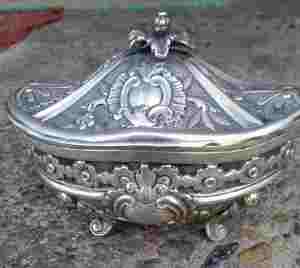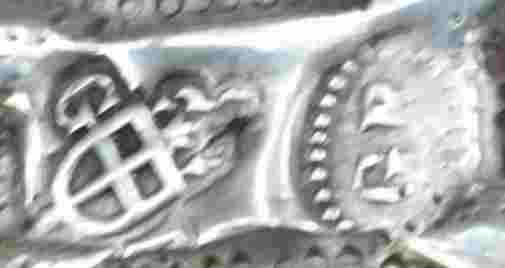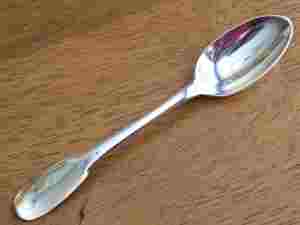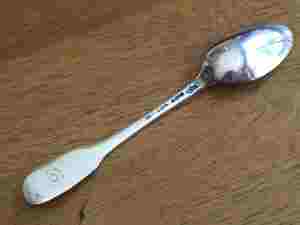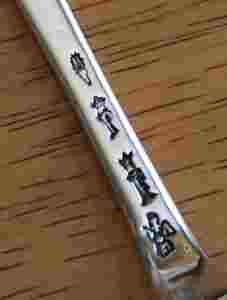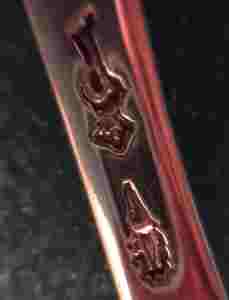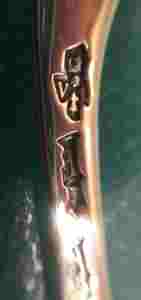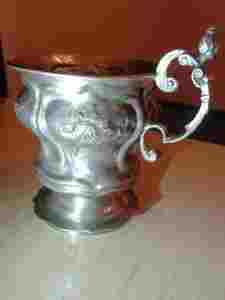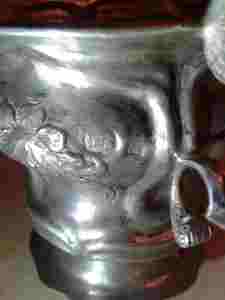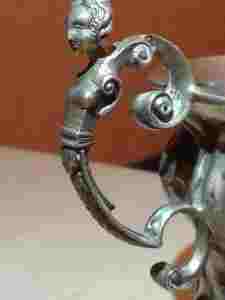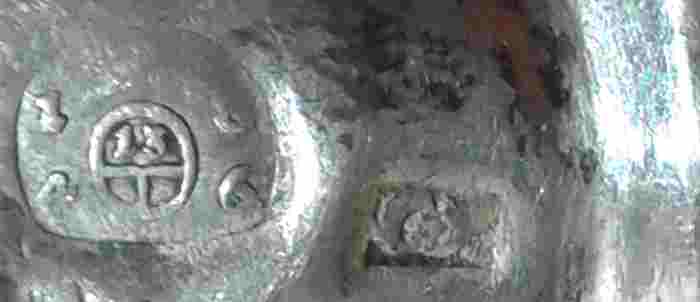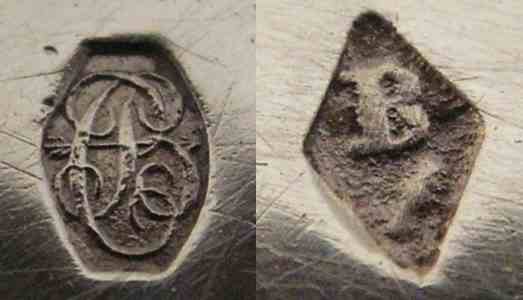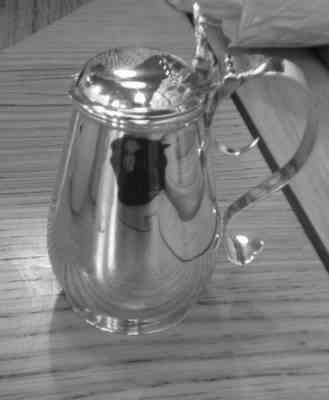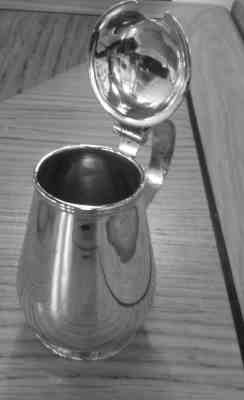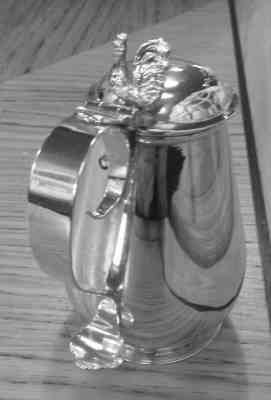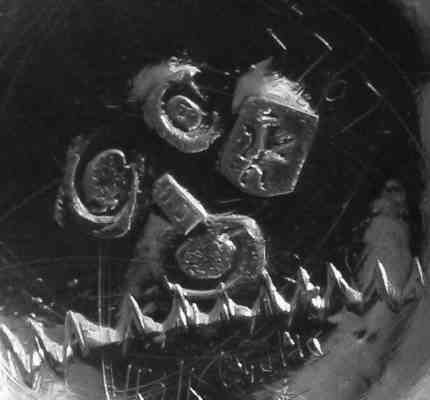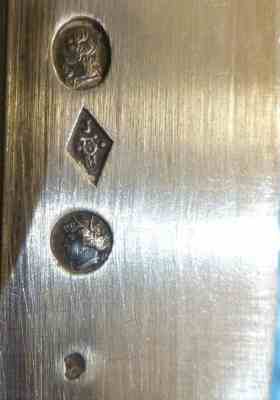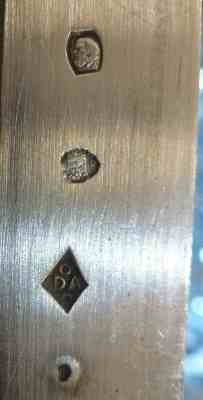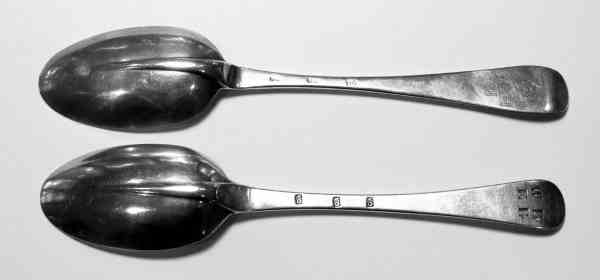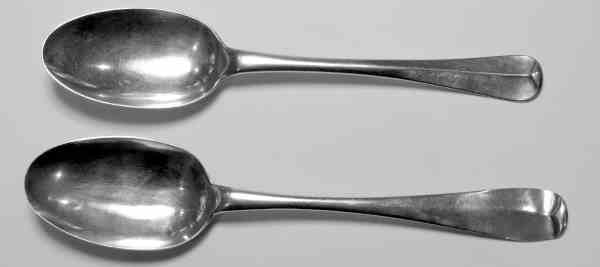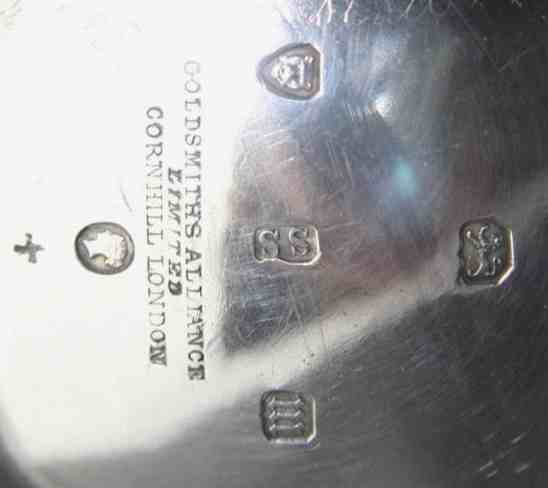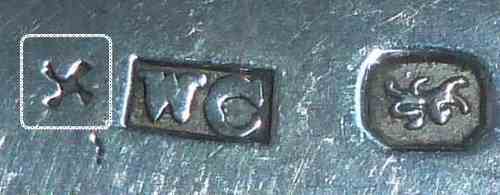
David McKinley presents:
Journeymen's Marks

... Such a mark is the identifying mark of the actual workman
who made the piece and who was employed by the "maker" (now
sponsor) whose mark must appear by law and is registered at
Goldsmiths Hall.
No such register was kept for journeymen and the matter of
establishing who worked for whom an area of research is still
waiting to be undertaken.
These journeymen were craftsmen who had been made free of a
Livery Company having completed a term of apprenticeship under
the guidance of a master goldsmith and were thus qualified to
practice their craft. However to set up a workshop was an
expensive undertaking and a young man newly qualified was
unlikely to have the necessary finance for such an undertaking
until he had worked in an established workshop for some time.......
click
here

Welcome to new ASCAS members:
Mirjam Knotter - The Netherlands
Laura Nelson - USA
Diana Sprout - USA
Vladimir Jekic writes:
...Can anyone tell me what kind of hallmark is in this spoon?
What kind of silver and where from?
Thank you.
Vladimir Jekic
Ian Spellerberg writes:
...Does anyone have any primary information as to what these
silver blades were made for? The longest is about nine inches
(22.5 cm.).
From top to bottom: Made by Gorham C. 1880; made by B.B. & B.
Co.; made by Shreve, Crump and Low; bottom, also by Shreve,
Crump and Low, C. 1927.
We have been unable to find any information in old trade
catalogues. Similar blades were made by Sampson Mordan & Co. Two
of the above blades have inscriptions with literary connections.
We are certain that they are not "tongue depressors" nor are
they likely to be page markers.
Thank you.
Ian Spellerberg
Possibly these blades were used to cut page deckle edge
in old books
Giorgio Busetto
Cheri Fowler writes:
...I have looked for days and can't find this mark.
Would you have any idea please?
Cheri Fowler
These are marks of the Kingdom of Sardinia (Piedmont,
Turin, Italy). The shield with the cross inside is the symbol of
Savoy dynasty. I know other similar marks, but I have no
information about the mark with letter G. The mark "GR" is the
assayer's mark of Giovanni Battista Raspi, Assay Office of Turin,
from 1818 ...
Details about Kingdom of Sardinia marks in my website at
http://www.silvercollection.it/TORINOHALLMARKS.html
Giorgio Busetto
I trust in the help of ASCAS members to identify this
French silversmith
Giorgio Busetto
Yosef Shlingbaum writes:
...I just purchased the attached wine cup. The stamps show
"Vienna 13 silver 1846" (plus not recognized stamp).
The cup bears headed handle and its magnificent work and design
doesn't look for the use of just drinking wine. It may be made
for prayer or use at chapel.
Do you have any idea for the use of this cup?
Thank you
Yosef Shlingbaum
Laurence Joyce writes:
...Do you or any of your ASCAS members know what the additional
marks mean on this 1821 fiddle pattern tablespoon by Francis
Higgins?
I guessed the cross in a diamond was a journeyman's mark, but
it's not one I've seen before. Of the other marks, the HA looks
like a watchmaker's incuse mark and the P in a shaped surround
looks like an import/export mark of some kind but I haven't been
able to track it down. AWP I'm guessing is a retailer but
perhaps it will mean something to someone.
I would be very grateful for any suggestions.
Laurence Joyce
Peter van Oel writes:
The first image shows the maker's and assayer's mark of Jean
Baptiste Philippe Brichaut, born in Brussels March 1761, active
registered silversmith 1798-1800, assayer on duty in Brussels
1800-1832.
The 2nd image shows the maker's mark of Henri Pierre Buchet,
born in Vilvoorde, October 1786, active registered silversmith
in Brussels 1812-1826, died in Brussels December 1826
Peter van Oel
Ludo D'Haese writes:
In answer of Christophe Ginter request:
First mark: BC run through with an arrow:
Brichaut Jean Baptiste Philippe 1761-1839 Silversmith of
Brussels. Appointed in 1800 as "essayeur du bureau de Garantie
de Bruxelles" until 1831.
His son, Albert Joseph, used also the same mark after 1847.
Second mark: B above faggot:
Buchet Henri Pierre 1786-1826. Silversmith of Brussels
(1812-1826)
Ludo D'Haese
Peter van Oel writes:
Certainly not Dutch or Belgian marks and I believe the marks
to be fantasy or pseudo marks. You write; In addition to the
marks on the base of the pot there is a tax mark for locally
made silverware in the form of a fish with scales in a shaped
shield next to the hinge and on the inside of the lid. If I
understand correctly, you refer to a South African tax mark for
items locally made, if so the mustard pot is most likely made in
South Africa somewhere in 20th century.
Peter van Oel
Robert Massart writes:
I have following information for Pascal Drion:
The mark JM stands for the Parisian silversmith Jean-Baptiste
Massat (active from 1826 till 1853). Symbol: a lyre with a dot
at each side.
I do not know the name of the silversmith with the DA mark, but
he was active at Vienne, Poitiers (department number 81 for the
period 1819-1838).
Robert Massart
Christophe Ginter writes:
The first one, Paris 1819-1838, obviously Jean Baptiste
MASSAT, initials JM, registered 1826-1853
The other knives presumably POITIERS in the province. Silver
maker DA, I cannot read properly. Confirming the 1819-1838
period.
Best regards,
Christophe Ginter
Jan-Gabriel Lamorte writes:
1) JM. une lyre entre deux points; une lyre et deux points de
chaque côté. Jean-Baptiste Massat, La Coutellerie, 35 rue
Montmartre, puis 7 rue de la Monnaie à Paris. 1ère Insculpation
2 janvier 1826, au 23 novembre 1853, puis 2 ème insculpation,
non biffée.
2) 3) DAL; une clef de pendule, le canon en-bas et deux points.
Denis Alexandre Lecomte, Bijouterie; l'uni et l'ajusté, 33 rue
de la Calandre Insculpation: octobre/novembre 1806.
Bien cordialement
Jan-Gabriel Lamorte
Christophe Ginter writes:
Regarding these spoons:
presumably...French silver items, First half XVIIIth century,
produced by so-called "maîtres abonnés" silver makers in the
province, IB and CA?
I may not properly read the attached pictures, and give
consequently an ultimate opinion.
Christophe Ginter

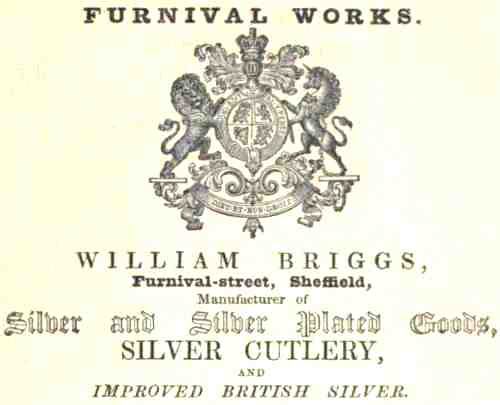
|
This month ASCAS presents an ancient advertisement
of:
WILLIAM BRIGGS
Furnival-Street, Sheffield
Manufacturer of
Silver and Silver Plated Goods
Silver Cutlery
and
Improved British Silver
Formerly Furniss, Pole & Turner. Active until
1958 at Button Lane 21, Carver St 13, Carver Lane 38
and Furnival St, Sheffield. Became Roberts & Briggs
and later Roberts & Belk
This image is part of the
ADVERTISEMENTS IN SILVER - SILVER ADVERTISING
section of www.silvercollection.it website
|
"A WORD per MONTH"


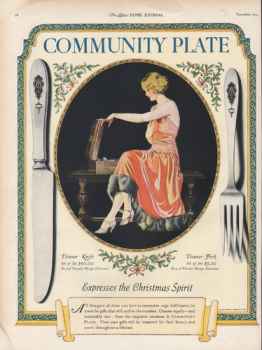
|
FLATWARE PATTERNS
ONEIDA SILVERSMITHS
COMMUNITY PLATE
About 1848 John Humphrey Noyes and a little
association of men began an experiment in communal
living at Oneida Creek. In 1877 the Oneida Community
began the manufacture of tableware. The production of
iron spoons called "Lily" and "Oval" manufactured by the
Wallingford branch was the direct ancestor of the
Community Plate line. In 1880 the activity was
incorporated in New York as Oneida Community Limited and
the factory was moved to Niagara Falls.
The first flatware Design Patterns were obtained by the
company in 1881, but its production couldn't compete
with higher quality silver made by other companies....
more
|
"A SILVERSMITH per MONTH"
|
|
SMILY FAMILY
WILLIAM SMILY - WILLIAM ROBERT SMILY - SAMUEL SMILY -
THOMAS SMILY
William Smily (born in 1792)
was apprenticed in 1809 to Joseph Preston, spoon and
fork maker.
In 1815, following the death of Joseph Preston, he was
turned over to Thomas Wallis II to complete his
apprenticeship. However he did not took up his freedom
of the Goldsmiths' Company until 1830 (freedom by
Service at the address Gee Street, Goswell Street).
It is likely that, at that time, he had commenced to
work in the factory of A.B. Savory & Sons at 15 Gee
Street.
His son William Robert Smily was apprenticed to him in
Gee Street in 1833, obtaining his freedom in 1840.
In 1840 William Smily is recorded as residing and
working at 5 Finsbury Place South, the address of
another of Savory's factories where also the other two
sons were apprenticed to their father (Samuel Smily I in
1840 and Thomas Smily in 1841)......
more
|
Closing our JUNE 2015 edition of ASCAS Newsletter I hope you
have appreciated its content.
Your comments, suggestions and advice will be of great help.
My thanks to Ludo D'Haese, Cheri Fowler, Christophe Ginter,
Vladimir Jekic, Laurence Joyce, Jan-Gabriel Lamorte, Robert
Massart, David McKinley, Richard Mytton-Mills, Yosef Shlingbaum,
Ian Spellerberg, Peter van Oel for their precious contributions.
Giorgio Busetto
Secretary
DISCLAIMER AND PRIVACY POLICY
ASCAS is a community of people having a common
interest in antique silver.
It is a non-profit association without commercial links.
Membership is open to whomever has a true interest in
this subject matter.
ASCAS has no real property and no fees are requested nor
accepted from members.
ASCAS keeps in touch with its members only through
periodical newsletters, e-mails and web-site updating
and ignores and is not responsible for any other
activity pursued by its members.
Likewise, ASCAS is not responsible for opinions,
evaluation and images displayed, and in any form
published or supplied for publication, by its members
who, in any case, maintain the property of their works
and assure the respect of national and international
legislation about Intellectual Property.
ASCAS does not have the full addresses of its members (only
town, country and e-mail address are requested for
membership).
ASCAS handles and protects with care its members' e-mail
addresses, will not disclose the addresses to third
parties, will use this information only to reply to
requests received from members and for communications
strictly related to its activity.
These rules are expressly accepted by submitting the
membership request.
|
|
 newsletter
# 133 June 2015
newsletter
# 133 June 2015









